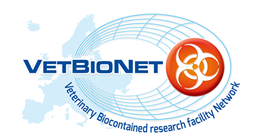Public Deliverables
- D1.3_List of samples available from collections and procedure
- D3.3_Biorisk management programme for facilities handling large farmed animals
- D3.4 Guidelines of minimum requirements and criteria for training provision and competency assessment
- D3.4 Annex: Guidelines of minimum requirements and criteria for training provision and competency assessment for operating high containment farmed animal facilities
- D3.4 Annex: Addendum Fish experimental facilities
- D3.5 Training material for specific critical positions in animal high containment facilities
- D3.6 Process guidelines for designing and upgrading BSL3/3+facilities for farmed animal species including design and assessment
- D3.6 Annex: Process guidelines for designing and upgrading BSL3/3+ facilities for farmed animal species
- D3.7 Guidelines for best practice in Post-Mortem facilities
- D3.8 Updated guidelines for best practice and procedure exchange of aquatic animal infection facilities
- D3.9 Position paper for policy makers on the biosafety of alkaline hydrolysis (biodigesters) as an alternative destruction technique to incineration based on the practical experience gained in the sector in Europe
- D3.10_Report on Best Practice for facility management
- D4.1_Open Science and Stakeholder Engagement Strategy Report
- D4.2 Analysis of ethical issues in BSL3/BSL3+ animal infectious disease research Report
- D4.3 Animal infectious disease research, social impact and contributions to the EU bio-based economy: Animal Infectious Disease Research in COVID times
- D4.4 VetBioNet Guidance on Implementation of the 3Rs and EU Animal Experimentation Directive
- D4.5_Ethics Committee Best Practice Guidance
- D4.6: Creating ‘Safe Spaces’ for research and animal ethics debate
- D5.1 Creation of the website and communication package
- D5.2_Creation of the Data Management Plan (DMP)
- D5.3 Organization of 1 Summer Course at EAAP premises
- D5.4_VetBioNet 3Rs Training Event Professional Training School in Experimental Design
- D5.5_Two short videos targeting veterinary laboratories and general public:
- D5.6 Organization of 1 Summer Course at IRTA premises
- D5.8 Organization of 1 Summer Course at RI premises
- D5.9 Three webinars available online
- D5.10 Event targeting Policy makers
- D5.11 Organization of 1 Summer Course at INRAE Premises
- D5.12 E-learning platform
- D5.13 Organization of the final conference
- D6.1_List of Activities of Interest to be maintained after the EU funding period
- D6.2 Draft prototype of structure and mode of operation for the future of VetBioNet
- D6.3 Draft plan outlining strategies for VetBioNet sustainability
- D6.4 ERG Agreement drafted for Partners willing to commit themselves after the end of the EU funding
- D6.5 Launch of the structure that will replace VetBioNet after current period of EU funding on the basis of the Sustainability Plan
- D7.2_Novel reservoir host infection models for BSL3 zoonotic pathogens
- D7.4 Improved fish model for relevant pathogens in aquaculture
- D7.5 Optimised pathogenesis and immunity models in genetic context for BSL3 pathogens
- D7.6 Novel avian/mammalian host models for airborne transmission and susceptibility
- D8.1_Development of a differential serological assay to separate RHDV infection from RHDV2
- D8.2 Development of alternative ELISAs for fish disease diagnostics and surveillance
- D8.3 Application of newly developed high throughput transcriptomic analytical tools NanoString and Fluidigm to livestock to examine the response to BSL3 pathogens
- D8.4 Development of high throughput class I MHC genotyping methods for sheep and cattle
- D8.5 Utilisation of NGS based tools to explore the T and B cell repertoires in domestic livestock before and after infection with BSL3 pathogens
- D8.6 Pulmonar microbiome effects related to porcine influenza infections
- D9.1_Prototype telemetry sensors and behavioral analysis software
- D9.2_Adaptation of light sheet confocal microscopy to the imaging of living pathogens
- D9.5 Validation of integrated telemetry and behavioural monitoring
- D9.6 Enhanced temporal and organ-specific readouts of infectious diseases models including more refined criteria for the application of humane end points in order to minimize animal welfare impact
- D9.7 Development and validation of molecular tags to study the interaction of class 3 viruses including organ and cell type tropism and host responses
- D11.1 Quantity of access provided over the duration of the project to INRA infrastructures
- D12.1 Quantity of access provided over the duration of the project to CVI, Wageningen Bioveterinary Research (WBVR)
- D13.1 Quantity of access provided over the duration of the project to FLI3
- D14.1 Quantity of access provided over the duration of the project to TPI
- D15.1 Quantity of access provided over the duration of the project to APHA
- D16.1 Quantity of access provided over the duration of the project to MRI
- D17.1 Quantity of access provided over the duration of the project to INIA-BSL3-CISA
- D18.1 Quantity of access provided over the duration of the project to IRTA Animal facility
- D19.1 Quantity of access provided over the duration of the project to IRTA Animal and BSL3 laboratories facilities
- D20.1 Quantity of access provided over the duration of the project to IRTA BSL3/2 laboratories
- D21.1 Quantity of access provided over the duration of the project to BSL3 lab & animal facility
- D22.1 Quantity of access provided over the duration of the project to viruses and virus-related reagents (EDI-IVI BSL3 Lab)
- D23.1 Quantity of access provided over the duration of the project to high-end molecular typing and immunological technologies
- D24.1 Quantity of access provided over the duration of the project to PIWET-MFB
- D26.1 Quantity of access provided over the duration of the project to AU-ANIS
- D27.1 Quantity of access provided over the duration of the project to “ANSES-Ploufragan Plouzané-Niort”
- D28.1 Quantity of access provided over the duration of the project to ANSES-Nancy
- D29.1 Quantity of access provided over the duration of the project to RI Containment laboratories
- D30.1 Quantity of access provided over the duration of the project to ErasmusMC
- D31.1 Quantity of access provided over the duration of the project to IZSVe
Training:
IRTA-CReSA Fall Course – Biocontainment & Biosecurity PPT presentations folder

